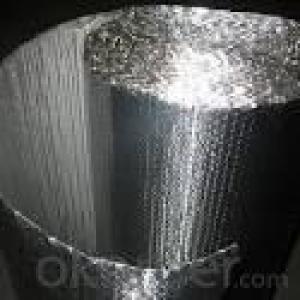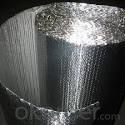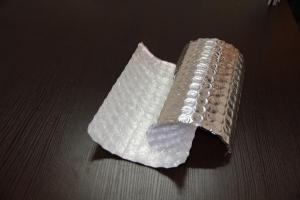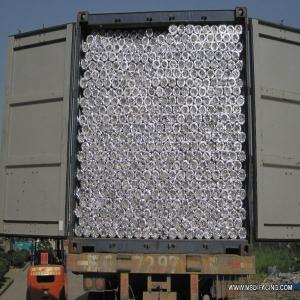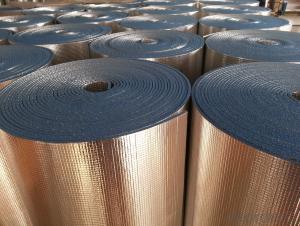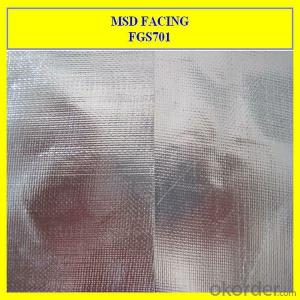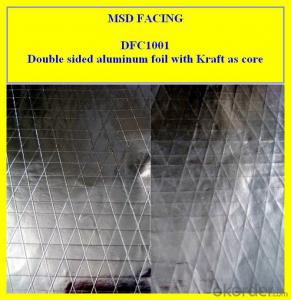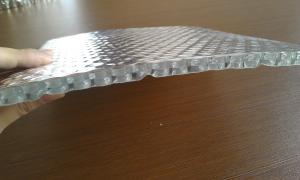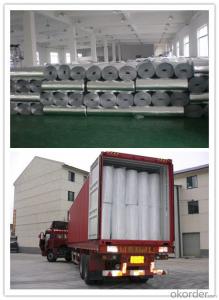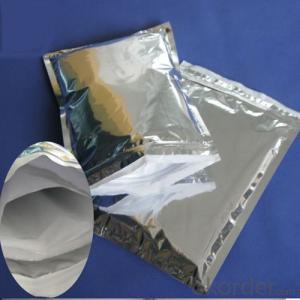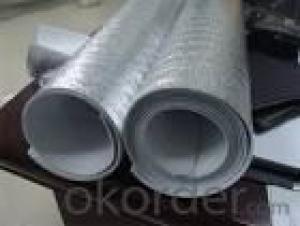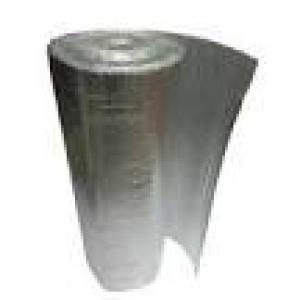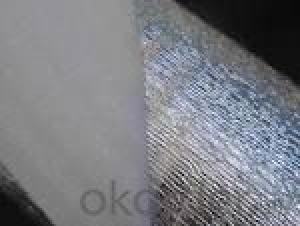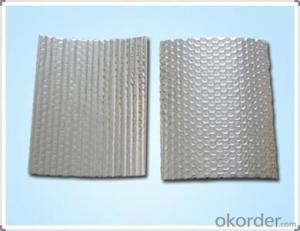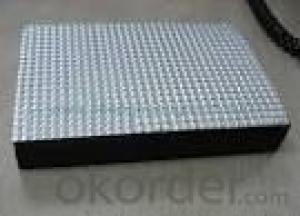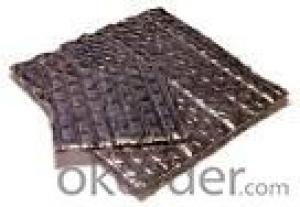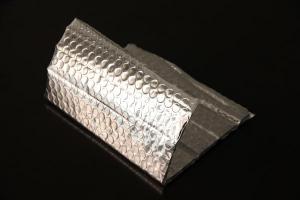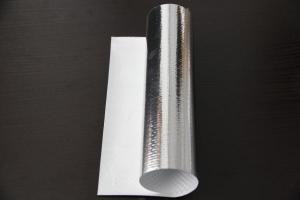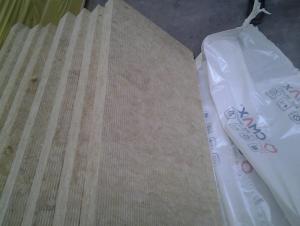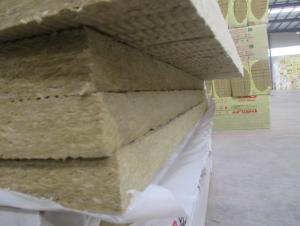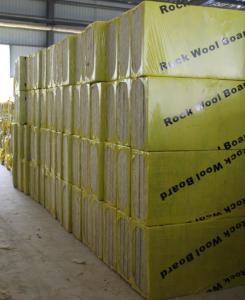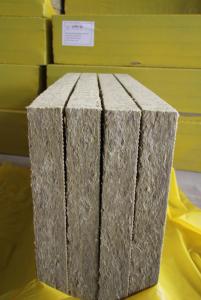Roofing Insulation Rock Wool Aluminum Foil Coated Bubble Insulation Type 22
- Loading Port:
- Shanghai
- Payment Terms:
- TT OR LC
- Min Order Qty:
- 10000 m²
- Supply Capability:
- 100000 m²/month
OKorder Service Pledge
OKorder Financial Service
You Might Also Like
Bubble Insulation Benefits:
Reflects 96% of radiant heat
Non-toxic / Non-carcinogenic
Does not require protective clothing or respirators to install
Durable and lightweight
Does not compress, collapse or disintegrate
Vapor and radon retarder
Easy to cut and install
Permanent and maintenance-free
Does not provide a growth medium or nutritive value for fungus, insects, or rodents
Does not support the growth of mold or mildew
Not affected by moisture or humidity
Lowers heating and cooling costs year round
Bubble Foil Application:
Metal & Steel Buildings
Homes
Roof Underlayments
Cathedral Ceilings
Crawl Spaces
Hot Water Heaters
Basement Walls
Floors
Garage Doors
Concrete slabs
Driveway snow melts
Pole barns
Post frame buildings
Poultry barns
Animal kennels
Temperature sensitive storage areas
Air Bubble Foil Insulation Tech Data:
Material Structure: AL/Bubble/AL | ||
Bubble Size:D10mm*H 4mm(10*2.5/10*4/10*6/20*7/25*10)choose the bubble size | ||
Bubble Weight:0.13kg/m2 ( can be customized ) | ||
Roll Width:1.2m (lenth can be customized) | ||
PROPERTIES | TEST DATA | UNIT |
Thickness | 3.5-4 | mm |
Weight | 250 | g/m2 |
Emissivity | 0.03-0.04 | COEF |
Thermal conductivity | 0.034 | w/m0 |
Apparent Density | 85 | kg/m3 |
Reflectivity | 95-96 | % |
Water Vapour Transmission | 0.013 | g/m2kpa |
Corrosion | doesn't generate | |
Tensile Strength(MD) | 16.98 | Mpa |
Tensile Strength(TD) | 16.5 | Mpa |
- Q: Our roof tile is installed on top of galvanized iron sheets. We do not have any toher form of insulation. The roof tile or tegula is quite thick.
- You can never have too much insulation, esp. in a roof. Heat rises, and a well-insulated roof helps with energy savings.
- Q: How do I find roofers who are specialised in protection against invaders from outer space. I called 10 and they said they would call me back, but no one did so far. It must be really complicated.
- Make a hat out of tin foil like some of the people in the mental hospital do. No roofer in his right mind would go near your house if you tell him this outlandish story you claim to be circulating about space invaders. Mentally unstable people tend to scare normal folks away in droves, see a therapist or get a new joke writer because I'm not buying it either.
- Q: Should a two story home have insulation under the roof in the big closets ?
- yea. it might cost you some to put it in but it will save you a lot in the future with heating and air conditioning bills
- Q: I live in central florida. I plan on installing R-30 insulation to the floor of my attic. How effective is it to install reflective insulation to the attic on the roof side? Is it worth the price?
- No dont add to the roof. The under side of the roof needs air flow and you will trap moisture, causing mold and rot. Make sure you have plenty of vents under your eaves and take your extra money and buy a solar powered attic fan (or 2 ) Mark
- Q: please help..
- Both fiberglass and asphalt products are harmful to your health. Stick to brands like Raamat, Secondskin, and Dynamat.
- Q: should thermal insulation ever be applied directly to the underside of a roof top?
- yes its done all the time on metal buildings. works well but expensive.
- Q: Re-roof + gutters + insulationHi. My name is Sean and I live in Adelaide. I want to get rid of my asbestos roof and replace it with a Colorbond roof and new gutters and also R3 ceiling insulation. I've had 1 quote so far for $17,000 total costs, and 1 quote for roof removal only which was $3,300. Does anyone know if I can get a cheaper quote but still get a good job done please?Roof area: 160m2 approx.Gutters: 25 linear metres approx.Capping: 52 linear metres approx.Cheers.
- I am a roof plumber in melbourne I think this is a reasonable price. Materials will cost approx 8000-10000 grand 3300 for asbestos removal and the rest for labour. The best advice is plenty of quotes and keep them to their quotes. If you can get a roll of metal direct from bluescope you can get a company like apex roofing to roll it for you but it is alot of mucking around to save a little bit
- Q: Can you put fiberglass insulation on the under side of roof tiles in the loft in the house?
- You should not be able to see your roof tiles from inside your house. So no, it can not be done. You can attach insulation to the rafters if that is what you meant.
- Q: House is a bi-level. Recently added storm windows to deck off dining room. Having a new rubber roof installed would like to know if we can insulate ceiling to make the room warmer. What product do you suggest we use. we are getting conflicting answers, some say you can insulate others say the ceiling needs to breath having a rubber roof install. Please advise.
- Your other answerer is correct. The little plastic pieces that he speaks of are sometimes called baffles. They look like they are corregated or wavy like the inside of cardboard. These are essential to letting air flow in the attic space. Another item that you must have are vents on the soffits or overhangs on either side of the roof. Air has to get in there somehow. There are alot of homes that are not ventilated properly and the roof decking or plywood gets discolored and rots from the inside out. Sometimes this can happen in as little as 5 years, depending on your geographical location. Rubber roofing is usually put on a flat roof system. If you do not have access to inside the framing, you cannot insulate or it will be very difficult to get insulation in there properly. There are so many variables with different houses and locations. You may want to ask an insulation expert from the phone book or even a home inspector. Good luck.
- Q: Finally remembering to do so, before my family and I left the house for approximately 4 hours, I turned off the heat before leaving. When we came home I turned it back on, but was shocked to see that the temperature had dropped 4 degrees in that time. 4 degrees in just under 4 hours seems like a lot of heat loss, does it not? I've seen the insulation in our roof and it's just that sawdust looking stuff spread everywhere. I feel like I'm paying a lot of unnecessary dollars for heating: the air does kick on every hour or two and we keep the thermostat at 68.Is it reasonable for me to talk to my landlord about this problem and getting better insulation in the ceiling, and maybe in the roof? (the master bedroom, on the far corner of the house, is always 2-3 degrees below the rest of the house). Are my expectations to not lose a degree of heat or more per hour unreasonable? Would a typical landlord consider this a problem worth discussing?
- I never turn my heat or ac off when I leave the apartment. I'd say you can ask all you want but the landlord won't be listening to you. And I don't think 4 degree drop is a lot. And it does depend on what the weather outside is. If I had 68 degrees indoors I'd always have a cold. What is your monthly bill and which part of the country are you in? My bill is around $42 a month. I have insulated draperies, I use only one 40 watt bulb at my place. When it gets cold in here my 40 watt bulb will heat my place.
Send your message to us
Roofing Insulation Rock Wool Aluminum Foil Coated Bubble Insulation Type 22
- Loading Port:
- Shanghai
- Payment Terms:
- TT OR LC
- Min Order Qty:
- 10000 m²
- Supply Capability:
- 100000 m²/month
OKorder Service Pledge
OKorder Financial Service
Similar products
Hot products
Hot Searches
Related keywords
